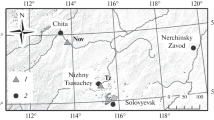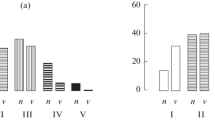Abstract
Using eight populations of Scots pine growing in foothills of the Sudetes (southern Poland) as an example, the character and causes of annual ring variation in 1900–1999 were studied. The climate had a short-term effect on radial growth during the whole period investigated. A long-term decrease of radial growth occurred after 1960, but only in some localities. It was probably caused by non-climatic factors, most likely by industrial pollution. The decline of trees during that period is mainly evidenced by a high variation of width of annual rings, a small similarity of chronologies of annual ring widths, and a lack of signal years. After 1990, the tree recovery process was evident. It was most intensive in localities where the earlier stress was the most severe. Then, trees started to produce wide annual rings, homogeneity of the growth reaction increased, and the signal years began to occur.






Similar content being viewed by others
References
Alcamo (1987) Future sulfur deposition scenarios in forested areas of Europe. In: Kairiukstis L, Nilsson S, Straszak A (eds) Forest decline and reproduction: regional and global consequences, Proceedings of the workshop held in Krakow, Poland, 23–27 March 1987, IIASA, Laxenburg Austria, pp 33–43
Cook ER, Holmes RL (1986) Users manual for program ARSTAN. In: Holmes RL, Adams RK, Fritts HC (eds) Tree-ring chronologies of Western North America: California, Eastern Oregon and Northern Great Basin, Chronology Series 6, University of Arizona, Tucson, pp 50–65
Eckstein D, Bauch J (1969) Ein Beitrag zur Rationalisierung eines dendrochronologischen Verfahrens und zur Analyse seiner Aussagesicherheit. Forstw Cbl 88(4):230–250
Eckstein D, Saß U (1989) Dendroecological assessment of decline and recovery of fir and spruce in the Bavarian Forest. In: Bucher JB, Bucher-Wallin I (eds) Air pollution and forest decline, Proceedings of the 14th international meeting for Specialists in Air Pollution Effects on Forest Ecosystems, IUFRO, Interlaken, 2–8 October 1988, pp 255–260
Eckstein D, Aniol RW, Bauch J (1983) Dendroklimatologische Untersuchungen zum Tannensterben. Eur J For Path 13:279–288
Eckstein D, Richter K, Aniol RW, Quiehl F (1984) Dendroklimatologische Untersuchungen zum Buchensterben im südwestlichen Vogelsberg. Forstw Cbl 103:274–290
Ermich K, Rutkowski B, Bednarz Z, Feliksik E (1976) The degree of similarity of dendrochronological curves as an indicator of site conditions. Tree-Ring Bull 36:1–8
Feliksik E, Wilczyński S (2003) Tree-rings as indicators of environmental change. EJPAU 6, 2, ser Forestry
Filipiak M, Ufnalski K (2002). Industrial pollution level and the increment of European silver fir in the Sudety Mountains. In: Siwecki R (ed) Biological reactions of trees of industrial pollution. Inst Dendrologii PAN, Kórnik, pp 513–520
Fritts HC (1976) Tree-rings and climate. Academic, London
Galiński W, Witowski J (1995) Oszacowanie emisji węgla spowodowanej przez zamieranie lasu wywołane gradacją owadów—nowy aspekt klęski ekologicznej w Sudetach. Prace IBL Ser B 25:37–42
Guttmeyer M (2002) Construction and operation history of the Turów Power Station. Energetyka 8:497–502
Holmes RL (1986) Quality control of crossdating and measuring. Users manual for computer program COFECHA. In: Holmes RL, Adams RK, Fritts HC (eds) Tree-rings chronologies of western North America: California, eastern Oregon and northern Great Basin, Chronology Series 6, University of Arizona, Tucson, pp 41–49
Huber B (1943) Über die Sicherheit jahringchronologischer Datierung. Holz als Roh- und Werkstoff 6, B 10/12:263–268
Juda J, Budzyński K, Jędrzejewski J, Juda-Rezber K, Abert K (1995) Stan zanieczyszczenia powietrza w Polsce w roku 19990 i prognoza na rok 2000. In: Kozłowski S (ed) Prognoza ostrzegawcza zmian środowiskowych warunków życia człowieka w Polsce na początku XXI wieku, Zesz Nauk PAN 10, pp 49–80
Juknys R, Stravinskiene V, Vencloviene J (2002) Tree-ring analysis for the assessment of anthropogenic changes and rends. Environ Monit Assess 77:81–97
Kairiukstis L, Grigaliunas J, Skuodiene L, Stravinskiene V (1987) Physiological and dendrochronological indications of forest decline and their application for monitoring. In: Kairiukstis L, Nilsson S, Straszak A (eds) Forest decline and reproduction: regional and global consequences, Proceedings of the workshop held in Krakow, Poland, 23–27 March 1987, IIASA, Laxenburg Austria, pp 151–167
Kelly PM, Murno MAR, Hughes MK, Goodess CM (1989) Climate and signature years in west European oaks. Nature 340:57–60
Kicińska B, Miczyński J (2001) Air pollution by sulfur dioxide and nitrogen dioxide. In: Koźmiński C, Michalska B (eds) Atlas of climatic risk to crop cultivation in Poland, University of Agriculture in Szczecin, p 8
Koźmiński C, Michalska B, Nidzgorska-Lencewicz J (2001) Wind directions and velocities. In: Koźmiński C, Michalska B (eds) Atlas of climatic risk to crop cultivation in Poland, University of Agriculture in Szczecin, p 25
Krąpiec M, Szychowska-Krąpiec E (2001) Tree-ring estimation of the effect of industrial pollution on pine (Pinus sylvestris) and fir (Abies alba) in the Ojców National Park (southern Poland). Nat Conserv 58:33–42
McLaughlin SB (1985) Effects of air pollution on forests. JAPA 35(5):512–534
Miś R, Rączka G (2002) Effect of long-term industrial pollution on the increase in height of Scots pine (Pinus sylvestris L.). In: Siwecki R (ed) Biological reactions of trees of industrial pollution, Inst Dendrologii PAN, Kórnik, pp 431–440
Molski B (1987) Fir and pine phloem and wood growth retardation due to air pollution. In: Kairiukstis L, Nilsson S, Straszak A (eds) Forest decline and reproduction: regional and global consequences, Proceedings of the workshop held in Krakow, Poland, 23–27 March 1987, IIASA, Laxenburg, Austria, pp 115–122
Mooi J (1976) Verslag van onderzoek naar de invloed van langdurende. Künstmatige begassingen gedurende de jaren 1973–1974–1975. IPO Report 157:1–43
Oleksyn J, Fritts HC, Hughes MK (1993) Tree-ring analysis of different Pinus sylvestris provenances, Quercus robur, Larix decidua and L. decidua x L. kaempferi affected by air pollution. Arbor Kórnickie 38:89–109
Oleksyn J, Prus-Głowacki W, Giertych M, Reich PB (1994). Relation between genetic diversity and pollution impact in a 1912 experiment with East European Pinus sylvestris provenances. Can J For Res 24:2390–2394
Pollanschütz J (1987) Effects of air pollutants on forest growth. In: Kairiukstis L, Nilsson S, Straszak A (eds) Forest decline and reproduction: regional and global consequences. Proceedings of the workshop held in Krakow, Poland, 23–27 March 1987, IIASA, Laxenburg, Austria, pp 125–128
Pollanschütz J (1986) Zuwachsdepressionen bei Einzelbäumen in immissionsbelasteten Beständen. Proc 18, IUFRO World Congress, Div 4:1–8
Pretzsch H, Kölbel M (1988) Einfluß von Grundwasserabsenkungen auf das Wuchsverhalten der Kiefernbestände im Gebiet des Nürnberger Hafens. Ergebnisse ertragskundlicher Untersuchungen auf der Weiserflächenreihe Nürnberg 317. Forstarchiv Sonderdruck 59 H3:89–96
Przybylski T (1994) The danger to spruce existence in Sudety Mts. due to environmental pollution. Prace IBL Ser B 21:185–194
Schmid-Hass P (1989) Der Nachweis der Ursache des Tannensterbens an einem Beispiel. Forstw Cbl 108:244–254
Schulze ED, Lange OL, Oren R (1989) Air pollution and forest decline: a study of spruce (Picea abies) on acid soils. Ecological Studies, vol 77. Springer, Berlin, Heidelberg, New York
Schweingruber FH, Wehrli U, Allen-Rumo K, Allen M (1991) Weiserjahre als Zeiger extremer Standortseinflüsse. Schweiz Z Forstwes 142(1):33–52
Spain J, Pilcher JR (1994) Signature years in European oak chronologies A.D. 1600–1750 and possible climatic causes. In: Frenzel B (ed) Climatic trends and anomalies in Europe 1675–1715, Paleoclimate Res 13:123–131
Spiecker H (1999) Overview of recent growth trends in European forest. Water, Air, Soil Pollut 116:33–46
Spiecker H (2002) Tree rings and forest management in Europe. Dendrochronologia 20/2–1:191–202
Swedish Ministry of Agriculture (1982) Acidification today and tomorrow. Risbergs Tryckeri AB, Uddevala, Sweden
Trampler T, Smykała J (1988) Raport w sprawie uszkodzenia i obumierania lasów w Sudetach. IBL, Warszawa
Wilczyński S, Skrzyszewski J (2002) The climatic signal in tree-rings of Scots pine (Pinus sylvestris L.) from foot-hills of the Sudetic Mountains (southern Poland). Forstw Cbl 121:15–24
Wójcik R, Buczkowski R (2002) Spatial analysis of the distribution of tree stand damage caused by industry in the Świerklaniec Forest Division. In: Siwecki R (ed) Biological reactions of trees of industrial pollution, Inst Dendrologii PAN, pp 457–466
Zawada J (2001) Incremental symptoms in revitalization of Silver fir in the forests of Carpathian and Sudeten Mts. and their silvicultural consequences. Prac Inst Bad Leś ser A, 3:79–101
Acknowledgements
The investigations were supported by the Polish State Committee for Scientific Research (KBN) under grant No. 5PO6H10914 from 1998–2001. Warm thanks to Dr. Barry Brook (School for Environmental Research, Charles Darwin University) for revising the English language of the manuscript. I thank Dr. J. Skrzyszewski for tree-ring data.
Author information
Authors and Affiliations
Corresponding author
Additional information
Communicated by Hans Pretzsch
Rights and permissions
About this article
Cite this article
Wilczyński, S. The variation of tree-ring widths of Scots pine (Pinus sylvestris L.) affected by air pollution. Eur J Forest Res 125, 213–219 (2006). https://doi.org/10.1007/s10342-005-0106-2
Received:
Accepted:
Published:
Issue Date:
DOI: https://doi.org/10.1007/s10342-005-0106-2




